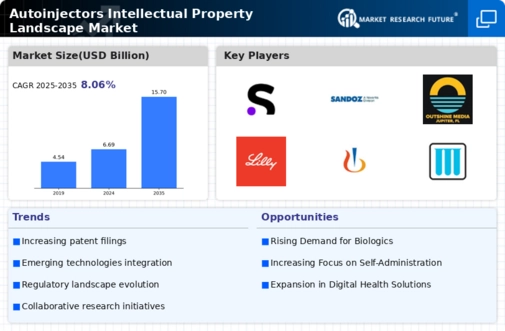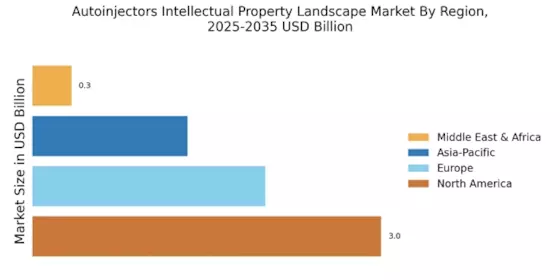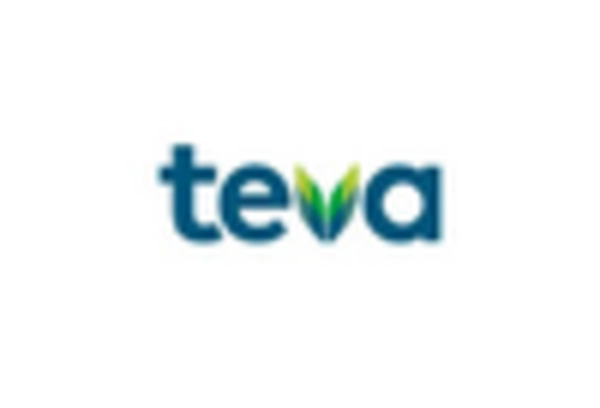Rising Demand for Biologics
The Autoinjectors Intellectual Property Landscape Market is experiencing a notable surge in demand for biologics, which are increasingly utilized in the treatment of chronic diseases such as diabetes and rheumatoid arthritis. This trend is driven by the growing prevalence of these conditions, leading to a heightened need for effective delivery systems. Autoinjectors, known for their ease of use and convenience, are becoming the preferred choice for patients. As a result, the intellectual property landscape surrounding autoinjectors is evolving, with numerous patents being filed to protect innovative designs and formulations. The market for biologics is projected to reach USD 500 billion by 2025, further emphasizing the importance of robust intellectual property strategies in this sector.
Regulatory Support for Autoinjectors
Regulatory bodies are increasingly recognizing the importance of autoinjectors in enhancing patient care, which is positively influencing the Autoinjectors Intellectual Property Landscape Market. Initiatives aimed at streamlining the approval process for autoinjectors are being implemented, thereby encouraging innovation and investment in this sector. For example, the FDA has introduced guidelines that facilitate the development of combination products, which include autoinjectors. This regulatory support not only fosters a favorable environment for new entrants but also incentivizes existing companies to invest in research and development. As a result, the number of patents related to autoinjectors is expected to rise, reflecting the growing confidence in the market's potential.
Technological Advancements in Drug Delivery
Technological advancements are significantly shaping the Autoinjectors Intellectual Property Landscape Market. Innovations in materials, design, and delivery mechanisms are enhancing the functionality and reliability of autoinjectors. For instance, the integration of smart technology, such as connectivity features and dosage tracking, is becoming increasingly prevalent. These advancements not only improve patient adherence but also create new avenues for patent filings. The market for smart autoinjectors is expected to grow at a compound annual growth rate of 15% over the next five years, indicating a strong potential for companies to secure intellectual property rights on cutting-edge technologies. This dynamic environment necessitates a strategic approach to intellectual property management to maintain competitive advantage.
Increased Focus on Patient-Centric Solutions
The Autoinjectors Intellectual Property Landscape Market is witnessing a shift towards patient-centric solutions, driven by the need for improved user experience and adherence to treatment regimens. Companies are increasingly investing in research to develop autoinjectors that are not only effective but also user-friendly. This focus on design and usability is leading to a proliferation of patents that protect innovative features such as ergonomic designs and simplified operation. Market Research Future indicates that patient adherence rates can improve by up to 30% with the use of user-friendly autoinjectors. Consequently, the intellectual property landscape is becoming more competitive as firms strive to differentiate their products through unique design elements and functionalities.
Collaborative Research and Development Initiatives
Collaborative research and development initiatives are becoming a cornerstone of the Autoinjectors Intellectual Property Landscape Market. Partnerships between pharmaceutical companies, technology firms, and academic institutions are fostering innovation and accelerating the development of new autoinjector technologies. These collaborations often result in shared intellectual property rights, which can complicate the patent landscape. However, they also create opportunities for companies to leverage each other's strengths and resources. The trend towards collaboration is expected to continue, with an estimated 40% of new autoinjector products being developed through joint ventures by 2025. This collaborative approach not only enhances the innovation pipeline but also necessitates a strategic focus on intellectual property management to navigate the complexities of shared ownership.


















Leave a Comment